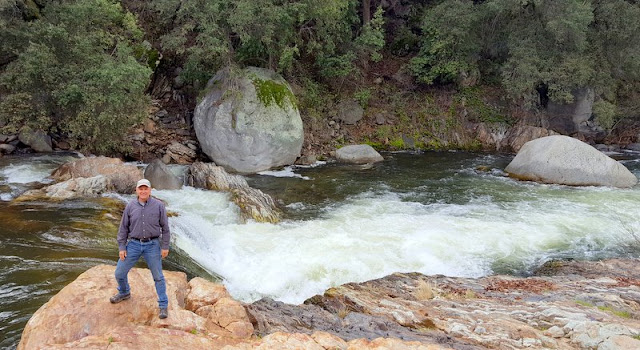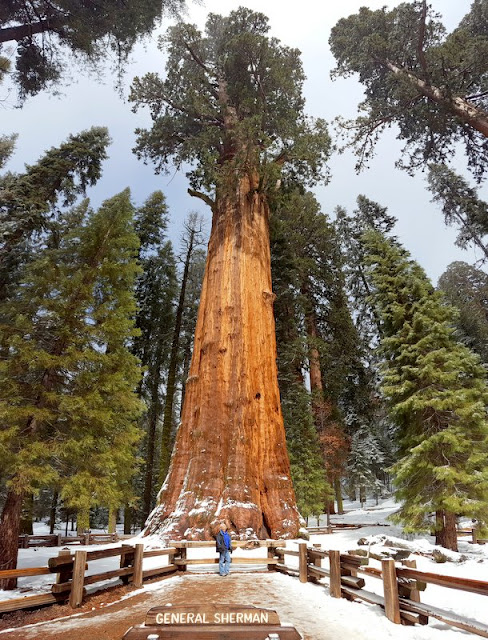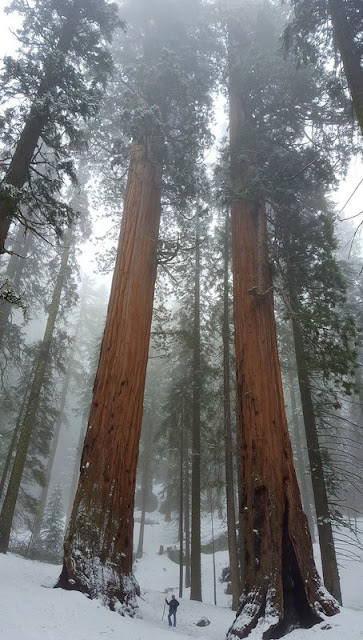We are camped in the town of Tulare, California. Again, we had to get lessons for how to pronounce our new home town. According to the locals, it sounds like "Two Larry." Our main reason for coming to Tulare was its vicinity to Sequoia National Park, and we headed to see the big Sequoia trees on our first full day here. There was a bit of a line at the entrance, as the ranger was giving each car the bad news--because of the snowfall last night, there are some sections of the park roads that will require tire chains. It is against California state law to enter these sections without chains in your vehicle. After hearing the speech, many of the entering vehicles (including us) made a U-turn in search of tire chains.
The ranger at the gate even provided a list of local businesses that sell or rent chains. We talked to several of them, and ended up buying this set available on Amazon for $19.99 for a mere $59. They might be taking advantage of a captive audience here in Three Rivers, California. We could rent them for the day for $39, but we decided to buy them. We intend to stay out of the snow in our travels, but sometimes you want to be where it is beautifully white in the winter.
With that detour taken care of, we finally got to head into the park. We picked this day because it had the best weather forecast for the time we were in the area. At our first stop at tunnel rock, we had to scoff at the possibility of needing tire chains on this beautiful day.
At these lower elevations, the lupines are growing in mounds the size of small cars.
We hiked down to the river that runs through the canyon in Sequoia National Park. We've heard all about the abundant winter rains that are making all of California greener than usual, and turning gentle rivers into white water.
You notice that Mark isn't even wearing a jacket. What was the fuss about inclement weather today?
We managed to hit the peak of the redbud tree blooms, whose bright purple buds can be seen up and down the valley.
We stopped in at Hospital Rock, to see the Native American petroglyphs left on some of the rocks nearby. This rock got its curious name because one of the early residents of this area came here in 1860 for medical help from the Potwisha Indians that wintered near the huge rock.
We took another hike, with a grand view of the river, the valley, and that touch of blue sky. Why did we spend $59 for snow chains on this beautiful weather day?
All of those activities were on the valley floor, and we found out the big trees we want to see don't grow down there. So we headed straight up the side of these mountains on a narrow, winding road. To complicate this climb, we are headed right into a blanket of fog.
It's a good thing we were going slow when this deer stepped out of the trees beside the road. She was walking so slowly, it looked like she couldn't see either.
She stayed right beside us as we carefully passed between her and her companion meandering through the fog.
We stopped at the overlook spot. You know its going to be a great panorama shot when they post a sign with a silhouette of a camera, indicating it was the best view of the valley and mountains in the entire park. This was our view this day.
We sensed the trees were getting larger as we climbed higher, but we really couldn't see them. Then we drove through the four sequoia trees that signal you have made it into their turf--the Four Guardsmen. We could actually see two of the four trees! Of course, there was barely enough room between the two to fit our one-laned road, so they were pretty hard to miss.
We were expecting to see snow over the road any time. When that happened we were ready to turn around. Mark was having to navigate up the road using only the lines on the side of the highway because the fog was too thick to see ahead. If those lines were covered with snow, it would just be too dangerous to continue in this fog. We were glad to safely make it to the Giant Forest Museum, with its signature Sequoia, "The Sentinel" standing steady for photo ops.
Normally there is a fence that keeps visitors away from the tree. But it was covered with snow, so we got our picture right at the base of this big boy. That is one huge tree!
Then we experienced our Sequoia miracle. The fog lifted, and we could suddenly see the road and the trees around us. What a view!
Even though the temperatures were hovering around freezing and there was new snow last night, the roads were clear for us to continue to our destination of the day.
We really had wanted to see the General Sherman tree, and we were blessed with a break in the clouds that gave us a bright picture of Denisa standing near its base.
It's almost impossible to get the entire tree into one picture, but we gave it a good try. Just a few minutes before, the top would have been shrouded in fog. But for this little window of time we are able to see all 275 feet of the world's largest tree in its entirety.
The General Sherman isn't the tallest tree, and it's not the widest tree in the world. But its combined height and girth together make it the biggest by volume. It is 102 feet in circumference at the ground. That's an awesome tree to stand beside!
After we had waited through the crowds for those pictures of General Sherman, we were ready to set out on a trail to find other examples of Sequoia royalty. The ranger at the museum explained that the Congress Trail was covered with snow, but he pointed out other trees that we might try to find. The path to these twin trees was well trampled.
The only way to take a picture of the twins is to use the panorama feature on the phone. The only problem is that it gives the twins a bit of a bow-legged curve.
As we walked through the snow-covered forest, we lost any semblance of the trail. The good news is we had this magnificent forest all to ourselves.
The bad news is that we might not find our way out of here until the spring thaw. We were making new tracks through the heaviest of the snow. Isn't it ironic that we snow skied in our shirt sleeves a few days ago, but today we needed our heaviest ski coats for this little hike in the forest?
We learned much about the life of these giants in the museum. For example, these trees are over 2,400 years old. Trees like this were being regularly chopped down before the national park protected them. The sad part is that sequoias usually splintered and broke when they hit the ground. They are not good timber trees, so many of these giants were made into pencils and orchard stakes for area grape vines.
Most of the trees have blackened areas along their base. Denisa is standing in front of one of those large black hollow spots. That's because they have survived many fires in the last 2,000 years. The mighty Sequoias can withstand fires around their toes and live to tell about it. Fires actually clean up the forest floor clutter and make it easier for them to grow even bigger.
Standing between . . .
and even inside these beautiful trees would be magical any day. But today in the snow was even better.
We've never considered ourselves to be "tree huggers" but today it seemed appropriate to hug one of these giants.
We have truly wandered into another of God's wonders, and we feel so blessed to be here!
The sun came out again, allowing us to take more pictures without that mysterious-looking fog. We even caught that sunshine streaming through those branches so far from the ground.
Mark is a tree climber from way back, but even he had to admit that the first branch was a little high off the ground. We also learned that this cinnamon-colored bark can be two feet thick on these old trees.
We really enjoyed this walk in the snow, wandering through the world's biggest trees all by ourselves.
In June we wouldn't have had to worry about fog or snow chains. But we would have encountered traffic jams and crowds on the trails.
We think our timing in March was just right!
After we had tramped through the snow among all those beautiful trees, it was finally time to come off this mountain high and head back to the real world. When we drove back down to the photo view point, we saw that the clouds had lifted enough that we could see the bottom half of the mountain, and the curvy road that we would take down to the valley.
It wasn't the blue-sky-clear-road day that we had envisioned in our mind. We think it was even better!





































No comments:
Post a Comment